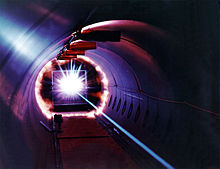This article needs additional citations for verification. (November 2021) |


Hypervelocity is very high velocity, approximately over 3,000 meters per second (11,000 km/h, 6,700 mph, 10,000 ft/s, or Mach 8.8). In particular, hypervelocity is velocity so high that the strength of materials upon impact is very small compared to inertial stresses.[1] Thus, metals and fluids behave alike under hypervelocity impact. An impact under extreme hypervelocity results in vaporization of the impactor and target. For structural metals, hypervelocity is generally considered to be over 2,500 m/s (5,600 mph, 9,000 km/h, 8,200 ft/s, or Mach 7.3). Meteorite craters are also examples of hypervelocity impacts.
- ^ Air Force Institute of Technology (1991). Critical technologies for national defense. AIAA. p. 287. ISBN 1-56347-009-8.